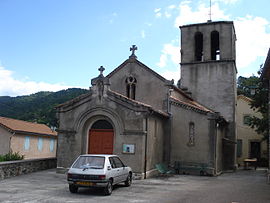Sainte-Cécile-d'Andorge
| Sainte-Cécile-d'Andorge | ||
|---|---|---|
| Commune | ||

The church of Sainte-Cécile-d'Andorge
|
||
|
||
| Coordinates: 44°15′10″N 3°58′37″E / 44.2528°N 3.9769°ECoordinates: 44°15′10″N 3°58′37″E / 44.2528°N 3.9769°E | ||
| Country | France | |
| Region | Occitanie | |
| Department | Gard | |
| Arrondissement | Alès | |
| Canton | La Grand-Combe | |
| Intercommunality | Pays Grand'Combien | |
| Government | ||
| • Mayor (2001–2008) | Jacques Pepin | |
| Area1 | 19.09 km2 (7.37 sq mi) | |
| Population (2008)2 | 559 | |
| • Density | 29/km2 (76/sq mi) | |
| Time zone | CET (UTC+1) | |
| • Summer (DST) | CEST (UTC+2) | |
| INSEE/Postal code | 30239 /30110 | |
| Elevation | 200–835 m (656–2,740 ft) (avg. 291 m or 955 ft) |
|
|
1 French Land Register data, which excludes lakes, ponds, glaciers > 1 km2 (0.386 sq mi or 247 acres) and river estuaries. 2Population without double counting: residents of multiple communes (e.g., students and military personnel) only counted once. |
||
1 French Land Register data, which excludes lakes, ponds, glaciers > 1 km2 (0.386 sq mi or 247 acres) and river estuaries.
Sainte-Cécile-d'Andorge is a commune in the Gard department in southern France.
The commune or Sainte Cécile d'Andorge is sparsely populated. It lies at the extreme north of the department of Gard, forming part of the border with Lozère. Its river, the Andorge here joins the larger Gardon d'Alès (sometimes known as the Long Valley) whose sources lie further up the valley in Lozère. The waters flow through this long cevenol valley through the former mining village of la Grand-Combe and down to the flatter land at Alès.
This was a coal mining area, with important collieries of high-grade coal both in this valley and at Portes. These mines closed in 1973.
There are three notable railways in the commune, one in operation, one under reconstruction and one defunct.
The waters of the Gardon d'Alès have been tamed by two dams forming two reservoirs. The first, the Barrage de Camboix, was a hydro-electric scheme designed to supplement the power for the coal mines at Grand-Combe, and the second, the barrage de Sainte Cécile, was designed as a holding reservoir to control the violent 'crue' the area suffers when violent storms in the hills send an uncontrolled surge of water down the river flooding low-lying houses and agricultural land.
Logo municipal
Gardon d'Alès near the village of Sainte-Cécile-d'Andorge
Viaduc sur l'Andorge on the TAC
Le lake de Sainte Cécile d'Andorge
The statue of Our Lady
The area has been depopulating since 1900.
The commune of Sainte Cécile d'Andorge has a long history. There are some prehistoric remains to be found such as tumuli and some paintings mainly in the hamlet of Ponchets. The current houses date from the 18th century and have been protected from modern development. They are mostly built from the local stone (schist).
Unusually for a village in the fiercely Protestant Cévennes, Sainte Cecile remained Catholic. During the Guerre des Camisards (1702 - 1705), it was the scene of violent action. On 11 October 1703 the villages of Sainte Cécile d’Andorge and Saint Julien des Points were set alight by Rolland et Jouanny; 800 to 900 Camisard attacked the papist village of Sainte Cécile d’Andorge, enraged by the dévastation of the previous months in the Hautes Cévennes. The residents took refuge in their fortified church but 9 were too slow and were slaughtered. Several days later, Abbé Vidal, curé de Sainte Cécile, lead a revenge attack on the neighbouring reformed parish of Blannaves. The church tower dates from the 13th century.
...
Wikipedia



